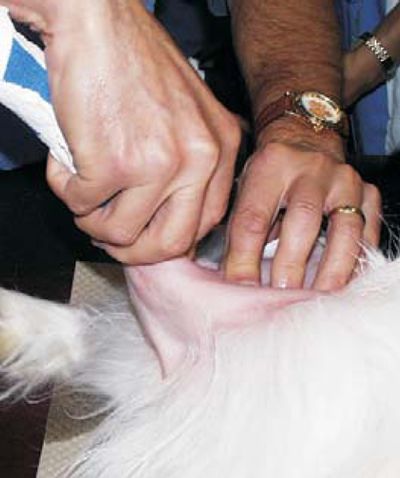Being a ball and socket joint, the shoulder joint is well suited for movement in all directions. Although capable of movement in all directions, the shoulder primarily moves in flexion and extension. Joint stability is provided through a combination of passive and active mechanisms. Passive mechanisms include the medial and lateral glenohumeral ligaments, surrounding joint capsule, joint conformation, and synovial fluid cohesion. The medial collateral ligament (MCL) commonly appears as "y" shaped with the cranial arm coursing caudally from its origin at the medial surface of the supraglenoid tubercle. The caudal arm of the MCL originates from the medial surface of the scapular neck and joins the cranial arm to insert onto the humeral neck. The MCL and associated joint capsule is a major factor in providing joint stability; complete medial luxation occurs following transection of the MGHL. The lateral collateral ligament (LCL) originates from the lateral rim of the glenoid and extends ventrally to insert onto the humerus at the caudal region of the greater tubercle. The joint capsule originates from the periphery of the glenoid cavity. Medially, the joint capsule forms a synovial recess due to its attachment several millimeters proximal to the glenoid rim. The concavity of the glenoid and the fit of the humeral head into the glenoid provide joint stability. This is particularly true when compression across the joint is enhanced by active muscle contraction.
Dynamic active glenohumeral stability is provided by contraction of the surrounding cuff muscles. These include the biceps brachii, subscapularis, teres minor, supraspinatous, and infraspinatous muscles. Active contraction of all or selective cuff muscles induce compression across the shoulder joint as well as increasing tension in the joint capsule.
When tested in neutral position, the cranial, lateral, and medial translation of the humerus was significantly increased after biceps tendon transection. In the flexed position, translation of the humerus in the cranial and lateral directions was significantly increased after biceps tendon transection. In the extended position, the medial translation of the humerus was significantly increased after biceps tendon transaction.
Examination of the shoulder for stability should be done in the awake animal as well as under anesthesia. Flexion, extension, abduction, adduction, and rotational stability of the shoulder joint should be assessed. Circumduction of the shoulder with internal and external rotation of the humerus is performed to detect signs of subluxation. The abduction test is completed to assess medial restraint instability. The dog is placed in lateral recumbency with the forearm to be tested extended; the shoulder joint must be in slight external rotation to prevent a false positive test. The limb is gradually raised with a valgus maneuver (bringing the limb upward). A normal test is approximately 25 degrees of valgus movement. Abnormal movement exceeds 25 degrees and is often approximately 43 degrees. The importance lies in the determination of a side to side (right to left forearm) difference. An abnormal abduction test does not always signify medial restraint injury. We have documented cases with long standing unilateral forelimb lameness will have an abnormal abduction test in the lame limb. Our presumption is that the laxity is due to disuse atrophy and loss of strength of the cuff muscles and ligaments.
| Abnormal abduction test | 
|
|
| |
|
|
Arthroscopic view of case showing torn MCL |